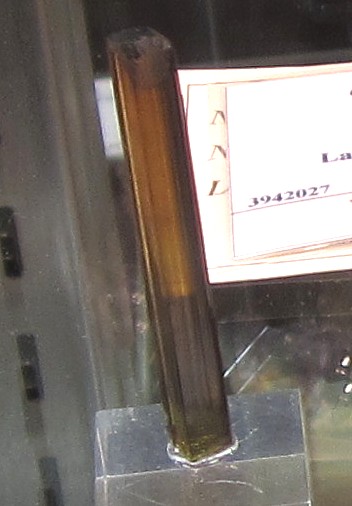|
.
Vesuvianite Mineral Facts:
Chemical Formula: Ca10(Mg,Fe)2Al4(SiO4)5(Si2O7)2(OH,F)4
A basic silicate of calcium
and aluminum which commonly also contains iron oxides, magnesia and
fluorine. It is extremely complex in composition.
Colors:
Commonly green or brown in color. Rarely in yellow,
blue, red.
Streak
is white.
Hardness:
6.5
Density: 3.5
to 4.45
Cleavage:
Poor cleavage on
(110).
Crystallography: Tetragonal
Crystals
are prismatic in habit. Often vertically
striated. Common forms are prisms of first and second
orders, pyramid of first order and base.
Some crystals show a more complex development with other
prisms, pyramids, ditetragonal forms, etc. It also occurs in
massive, columnar and granular forms.
Luster:.
Vitreous
luster. It is transparent to slightly translucent.
|

Vesuvianite Crystal |
|
Composition,
Structure and Associated Minerals:
Vesuvianite is a common
metamorphic mineral in certain limestones that have been metamorphosed by
granite and other igneous rocks. However it
is also found in serpentine
and in crystalline schists.
Vesuvianite is so named from its occurrence near the volcano of Vesuvius, where the
first specimens were obtained.
It is also called idocrase. Its principal alteration products are mica,
chlorite and steatite; and other minerals are also known to be formed from
it by weathering.
Identification
and Diagnostics
Before
the blowpipe
vesuvianite fuses with
intumescence to a swollen greenish or brownish glass. It is only slightly
soluble in acids but gelatinizes in hydrochloric acid after simple fusion.
It is decomposed with difficulty by acids, but after being strongly heated
it dissolves with the separation of gelatinous silica. The mineral powder
reacts alkaline. The mineral is characterized by its form when in crystals
and by its easy fusibility.
|

Vesuvianite |
|
|
Occurrence,
Localities and Origins:
Vesuvianite is a common metamorphic mineral in
crystalline
limestones, where it is
found in limestones that have been metamorphosed by the contact action of
granite and other
igneous
rocks. Formed probably by the action upon impure limestone of
hot vapors containing water and fluorine given off by the igneous
rock. Associated with other contact minerals, such as
garnet,
pyroxene,
tourmaline, chondrodite, etc.
The mineral was originally discovered
in the
thermally metamorphosed blocks of limestone ejected by volcanic eruption
from the
ancient ejections of Vesuvius and in the dolomitic blocks of
Monte Somma.
The vesuvianite of these
blocks occurs on the walls of cavities in the rock and is yellow to brown
in color. Vesuvianite is also found in crystalline schists where it occurs as well developed crystals
on the walls of veins containing
quartz,
calcite, garnet and
various ore
minerals.
Important localities include the following:
Fine crystals occur on the Mussa Alp in the Ala valley, Piedmont
associated with chlorite and diopside in a band of serpentine. Vesuviante is
also found at
Monzoni,
Tyrol; Vesuvius; Christiansand, Norway; Achmatoosk,
Urals; River Wilui, Siberia
at Zermatt and at other points in Switzerland;
at Vesuvius, in the Alathal, and the Albanian Mts., in Italy; and at many
places in Norway and Sweden.
In the United States,
good crystals occur
at Phippsburg
and Rumford, Maine; near Amity, New York; Inyo County, California;
in Canada at Litchfield, Pontiac County; and several locations in
California. In Canada it is found at Grenville,
Ontario; and at Templeton, Quebec.
Uses:
Vesuvianite has minor use as a gemstone.
The recognized varieties that are used as gems are
Californite, a white, green or gray and green variety in finely granular
masses, resembling jade.
Californite is a compact variety of vesuvianite. It is greenish in color and somewhat resembles
nephrite, with which it was at first
confused. It occurs near Happy Camp in Siskiyou County, California,
U.S.A., as lenticular masses in a sheared serpentine. It is also found
near Pulga in Butte County. This attractive fine grained variety also occurs in Inyo and Tulare Counties, in California.
Californite is best known from Indian Creek, Siskiyou Co., and
from a point 35 miles east of Selma, in Fresno Co., California. Other
localities are at Big Bar Station, Butte Co., and Exeter, in Tulare County,
in the same State. It is also known as
Cyprine, a blue variety containing copper which has been recovered at
Franklin, New Jersey and other locations.
Return to the
Mineral Collectors Information Page
|


